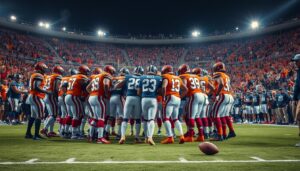The NBA Draft is an annual event where teams select eligible players to join the league. It helps teams build their rosters.
The NBA Draft serves as a critical mechanism for teams to acquire new talent. Each year, teams take turns selecting players from a pool of eligible prospects. This event can dramatically impact a team’s future success. Teams often scout players extensively, analyzing their skills, potential, and fit within the team’s system.
The draft includes two rounds, with 30 picks each, allowing 60 players to potentially enter the league. Top picks often receive significant attention and expectations. The draft process also includes trades and strategic decisions, making it a complex and exciting event for fans and teams alike.

Credit: www.nba.com
History Of Nba Drafts
The NBA Draft is a cornerstone event that shapes the future of basketball teams and players. The draft allows teams to select new talent, build their rosters, and maintain competitive balance. The history of NBA Drafts is rich with stories of triumphs, surprises, and evolutions that have impacted the sport dramatically.
Early Years
The NBA Draft began in 1947, a year after the league was founded. Initially, the draft was a simple affair, with teams picking players based on their records. The worst teams got the first pick, allowing them a chance to improve their squads.
In the early years, the draft consisted of numerous rounds. Teams could keep selecting players until they were satisfied. This meant that the drafts often lasted several hours and sometimes even days.
Some key points from the early years include:
- The first-ever draft pick was Clifton McNeely, selected by the Pittsburgh Ironmen.
- In 1950, Chuck Cooper became the first African American player drafted by an NBA team.
- The draft was not televised, and information was often relayed via newspapers or radio.
The early drafts laid the foundation for the modern NBA, setting traditions and practices that would evolve over time.
Evolution Of Rules
As the NBA grew in popularity, so did the complexity and rules of the draft. Initially, there were no formal rules governing eligibility. This changed in 1965 with the introduction of the “territorial pick” rule, allowing teams to forfeit their first-round pick for a local player.
In 1985, the NBA introduced the draft lottery system. This significant change aimed to deter teams from deliberately losing games to secure a higher draft pick. The lottery added an element of chance, making the draft fairer and more exciting.
Key changes in draft rules include:
- 1971: The “hardship rule” allowed underclassmen to enter the draft.
- 1989: The draft was reduced to two rounds, focusing on quality over quantity.
- 2006: The age limit was raised, requiring players to be at least 19 years old.
The evolution of these rules has made the NBA Draft an intricate and strategic process. Teams now invest heavily in scouting and analysis to make the best picks, ensuring the continued growth and excitement of the league.

Credit: www.hollywoodreporter.com
Draft Process Explained
Every year, NBA fans eagerly await the NBA Draft, a pivotal event where teams select new players to join their rosters. The draft process is a multi-step journey, from eligibility determination to extensive scouting and evaluation. Understanding this process is key to appreciating the hard work behind building a championship team.
Eligibility Requirements
To enter the NBA Draft, players must meet specific eligibility requirements. These rules ensure that only qualified athletes participate, maintaining the integrity of the draft.
- Age Requirement: Players must be at least 19 years old during the calendar year of the draft.
- College Experience: Players must be one year removed from high school. This rule encourages players to gain additional experience and maturity.
- International Players: International players must be at least 22 years old to be automatically eligible. If younger, they must declare their eligibility.
- Declaration: College players must declare their intention to enter the draft. This usually involves hiring an agent and notifying the NBA.
To better understand the eligibility criteria, here’s a table summarizing the key points:
| Criteria | Details |
|---|---|
| Age | 19 years old |
| College Experience | One year removed from high school |
| International Players | 22 years old or must declare |
| Declaration | Notify the NBA and hire an agent |
Scouting And Evaluation
Scouting and evaluating potential draft picks is a meticulous process involving numerous steps and a team of experts. This phase ensures teams make informed decisions on draft day.
Scouting: Scouts travel across the country and internationally to watch games. They look for standout players in high school, college, and overseas leagues. They attend games, practices, and tournaments, gathering data on player performance.
Evaluation: Once potential draftees are identified, teams conduct in-depth evaluations. This includes:
- Statistical Analysis: Analyzing player stats to assess performance and potential.
- Interviews: Conducting interviews with players, coaches, and even family members to understand the player’s character and mindset.
- Workouts: Inviting players to team facilities for workouts and drills to see how they perform under direct supervision.
- Medical Exams: Running comprehensive medical exams to check for any underlying health issues.
Additionally, teams use advanced technology and analytics to compare players. This helps in predicting how players will adapt to the NBA level.
Here is a simple breakdown of the scouting and evaluation process:
| Step | Details |
|---|---|
| Scouting | Watching games, practices, and tournaments |
| Statistical Analysis | Analyzing player statistics |
| Interviews | Talking to players, coaches, and family |
| Workouts | Inviting players for drills |
| Medical Exams | Checking for health issues |
This thorough process helps teams make the best choices, aiming to build a strong and competitive roster.
Notable Draft Classes
The NBA Draft has seen many players who changed the game. Some draft classes stand out for their talent and impact. These notable draft classes produced future Hall of Famers and legends. They shaped the NBA and left a lasting legacy.
2003 Class
The 2003 NBA Draft Class is often called one of the best ever. This class included many future stars and Hall of Famers. Here are some of the key players:
- LeBron James: Drafted 1st overall by the Cleveland Cavaliers. LeBron is a four-time NBA champion and MVP.
- Carmelo Anthony: Picked 3rd by the Denver Nuggets. Melo is a ten-time All-Star and Olympic gold medalist.
- Dwyane Wade: Selected 5th by the Miami Heat. Wade is a three-time NBA champion and Finals MVP.
- Chris Bosh: Chosen 4th by the Toronto Raptors. Bosh is an eleven-time All-Star and two-time NBA champion.
These players have left a huge mark on the NBA. They have combined for numerous All-Star appearances and championships. They have also been role models on and off the court.
| Player | Team | Achievements |
|---|---|---|
| LeBron James | Cleveland Cavaliers | 4x NBA Champion, 4x MVP |
| Carmelo Anthony | Denver Nuggets | 10x All-Star, Olympic Gold Medalist |
| Dwyane Wade | Miami Heat | 3x NBA Champion, Finals MVP |
| Chris Bosh | Toronto Raptors | 11x All-Star, 2x NBA Champion |
1984 Class
The 1984 NBA Draft Class is legendary. This class produced some of the greatest players in NBA history. Key players from this class include:
- Michael Jordan: Drafted 3rd by the Chicago Bulls. Jordan is a six-time NBA champion and MVP.
- Hakeem Olajuwon: Picked 1st by the Houston Rockets. Olajuwon is a two-time NBA champion and MVP.
- Charles Barkley: Selected 5th by the Philadelphia 76ers. Barkley is an eleven-time All-Star and MVP.
- John Stockton: Chosen 16th by the Utah Jazz. Stockton is a ten-time All-Star and assists leader.
These players redefined their positions and set new standards. They have collected multiple awards and accolades. Their influence on the game is still felt today.
| Player | Team | Achievements |
|---|---|---|
| Michael Jordan | Chicago Bulls | 6x NBA Champion, 5x MVP |
| Hakeem Olajuwon | Houston Rockets | 2x NBA Champion, MVP |
| Charles Barkley | Philadelphia 76ers | 11x All-Star, MVP |
| John Stockton | Utah Jazz | 10x All-Star, Assists Leader |
/cdn.vox-cdn.com/uploads/chorus_image/image/73430211/2159424719.0.jpg)
Credit: www.netsdaily.com
Impact On Teams
The NBA Draft is a pivotal event that can shape the future of franchises. Teams eagerly await their chance to pick the next superstar. The impact on teams is profound, influencing their strategies and success for years to come. Let’s dive into how the NBA Draft affects teams.
Building A Franchise
Building a franchise through the NBA Draft is a key strategy for many teams. This process allows teams to acquire young talent with the potential to become stars. Here are some ways the draft helps in building a franchise:
- Foundation Players: Draft picks often become the cornerstone of a franchise. Players like LeBron James and Tim Duncan were drafted and led their teams to multiple championships.
- Team Identity: Drafting the right player can set the tone for the team’s playing style and culture. For instance, Steph Curry’s shooting ability transformed the Golden State Warriors.
- Cost-Effective Talent: Rookies generally have lower salaries compared to veteran players. This allows teams to build a competitive roster without exceeding their salary cap.
Teams also use the draft to fill specific needs. A team lacking a strong point guard will likely focus on the best available point guard in the draft. This targeted approach ensures that teams remain balanced and competitive.
Trade Strategies
Trade strategies surrounding the NBA Draft can significantly impact a team’s success. Teams often trade draft picks to acquire veteran players or move up in the draft order. Here are some common trade strategies:
- Trading Up: Teams trade their current picks along with other assets to move higher in the draft. This helps them secure a top-tier player who can make an immediate impact.
- Acquiring Veterans: Teams trade their draft picks for experienced players. This strategy is useful for teams looking to win now rather than develop young talent.
- Future Picks: Sometimes, teams trade their current picks for future draft picks. This allows them to build long-term success by accumulating assets.
| Trade Type | Benefits | Examples |
|---|---|---|
| Trading Up | Secure top talent | Boston Celtics trading for Jayson Tatum |
| Acquiring Veterans | Immediate impact | Lakers trading for Anthony Davis |
| Future Picks | Long-term planning | Thunder acquiring multiple future picks |
These trade strategies allow teams to tailor their rosters according to their short-term and long-term goals. Effective use of trades can turn a struggling team into a championship contender.
International Players
The NBA Draft has become a global event. International players are making a huge impact. Teams are scouting talent from all over the world. These players bring new skills and styles to the game. The draft is no longer just about American college stars. It’s about finding the best talent anywhere in the world.
Global Scouting
Global scouting is vital for the NBA Draft. Teams send scouts to every corner of the world. They look for the next big star. Scouts watch games in Europe, Asia, Africa, and South America. They attend international tournaments and youth camps. They analyze stats and watch game tapes. Their goal is to find hidden gems.
Scouts focus on several key areas:
- Skill Level: Can the player shoot, pass, and dribble?
- Athleticism: Is the player fast and strong?
- Basketball IQ: Does the player make smart decisions on the court?
- Character: Is the player a good teammate?
Scouting is a tough job. Scouts travel a lot. They spend months away from home. They watch countless games. They talk to coaches and trainers. They need to make the right picks. A good pick can change a team’s future.
| Region | Top Player |
|---|---|
| Europe | Luka Dončić |
| Africa | Joel Embiid |
| Asia | Yao Ming |
Success Stories
Success stories of international players are inspiring. These players have become NBA stars. They come from different countries. They have different backgrounds. They show that talent can be found anywhere.
Some of the most famous success stories include:
- Luka Dončić: From Slovenia, Luka is a superstar. He plays for the Dallas Mavericks. He was the Rookie of the Year in 2019.
- Giannis Antetokounmpo: From Greece, Giannis is known as the “Greek Freak.” He plays for the Milwaukee Bucks. He won MVP awards in 2019 and 2020.
- Dirk Nowitzki: From Germany, Dirk is a legend. He played for the Dallas Mavericks. He won an NBA Championship in 2011.
These players have achieved great success. They have won awards and championships. They have become role models. They show young players that hard work pays off. They prove that the NBA is a global league.
Draft Day Experience
The NBA Draft is an eagerly awaited event that marks the beginning of many young athletes’ professional careers. The Draft Day Experience is filled with emotions, drama, and high expectations, making it a memorable occasion for players, families, and fans alike.
Event Atmosphere
The atmosphere on Draft Day is electric. The venue is packed with eager fans, media personnel, and team representatives. The excitement is palpable as everyone awaits the announcement of each pick.
Bright lights and flashy stages set the scene. Large screens display player highlights and stats, adding to the anticipation. The crowd buzzes with conversations about potential picks and trades.
Attendees often include:
- NBA legends and Hall of Famers
- Team executives and scouts
- Family members and friends of the draftees
Television networks broadcast the event live, bringing the experience into homes worldwide. Social media platforms are abuzz with live updates, making it a global spectacle.
| Aspect | Details |
|---|---|
| Venue | Large arenas or theaters |
| Attendees | Fans, media, NBA personnel |
| Broadcast | Live TV and online streaming |
Player Reactions
The reactions of players on Draft Day are priceless. For many, it is the culmination of years of hard work and dedication. The moment their name is called, a mix of joy, relief, and excitement washes over them.
Common reactions include:
- Tears of joy as they hug family members
- Wide smiles as they don their new team’s cap
- Emotional speeches during interviews
For some players, the wait can be nerve-wracking. They sit anxiously with their families, hoping to hear their name sooner rather than later. Their expressions often reflect the tension and anticipation.
Once selected, players walk up to the stage, shake hands with the NBA Commissioner, and pose for photos. This moment is immortalized in countless pictures and videos.
The Draft Day Experience is a rollercoaster of emotions for the players. It marks the start of their journey in the NBA and a dream come true.
Controversial Picks
The NBA Draft is always a thrilling event. Teams pick young talent, hoping they become stars. But not all picks go as planned. Some choices spark debates and drama. These are the Controversial Picks. Let’s dive into two main areas: Draft Busts and Unexpected Success.
Draft Busts
Draft busts haunt teams and fans alike. These are players picked high but fail to deliver. Let’s look at some famous busts:
- Sam Bowie: Picked before Michael Jordan in 1984. Injuries marred his career.
- Darko Milicic: Second pick in 2003. Played for many teams but never starred.
- Anthony Bennett: First pick in 2013. Played only four seasons in the NBA.
Busts happen for various reasons. Injuries, poor fit with the team, or off-court issues. Take a look at this table:
| Player | Draft Year | Pick Number | Reason for Bust |
|---|---|---|---|
| Sam Bowie | 1984 | 2 | Injuries |
| Darko Milicic | 2003 | 2 | Underperformed |
| Anthony Bennett | 2013 | 1 | Inconsistent Play |
These busts remind us that draft picks are risky. Teams need to scout and plan carefully. Even then, nothing is guaranteed.
Unexpected Success
On the flip side, some low picks surprise everyone. These players outperform expectations and become stars. Here are some examples:
- Manu Ginobili: Picked 57th in 1999. Became a Hall of Famer.
- Draymond Green: Picked 35th in 2012. Key player for the Warriors’ championships.
- Isaiah Thomas: Last pick in 2011. Became an All-Star.
These success stories show that talent can be found anywhere. Teams must scout diligently and give chances. Look at this table:
| Player | Draft Year | Pick Number | Achievements |
|---|---|---|---|
| Manu Ginobili | 1999 | 57 | 4x NBA Champion, Hall of Fame |
| Draymond Green | 2012 | 35 | 3x NBA Champion, Defensive Player of the Year |
| Isaiah Thomas | 2011 | 60 | 2x All-Star |
These unexpected successes remind us that the draft is unpredictable. Hard work and the right opportunity can lead to greatness.
Future Of Nba Drafts
The NBA Draft is a time of excitement and anticipation. Fans look forward to seeing which new stars will join their favorite teams. The future of NBA Drafts promises even more changes and innovations. Let’s dive into the emerging trends and potential reforms that could shape the next generation of NBA Drafts.
Changing Trends
In recent years, the NBA Draft has seen several changing trends that are transforming the landscape. These trends are driven by new technologies, analytics, and evolving strategies.
One significant change is the increasing use of advanced analytics. Teams now rely heavily on data to evaluate players. This includes metrics like player efficiency, shooting percentages, and defensive stats.
Another trend is the rise of international players. More teams are scouting talent from around the world. This has led to a more diverse and global pool of players entering the NBA.
Here are some key trends:
- Advanced Analytics: Teams use data to make informed decisions.
- International Scouting: More players from outside the U.S. are entering the draft.
- Positionless Basketball: Teams value versatile players who can play multiple positions.
These trends are reshaping how teams approach the draft. They are looking for more than just raw talent. They want players who fit their system and can contribute in various ways.
Potential Reforms
The NBA Draft might also see several potential reforms in the coming years. These reforms could address existing challenges and make the draft process more efficient and fair.
One possible reform is the introduction of a lottery system for all picks. This would prevent teams from intentionally losing games to secure a higher draft pick. It would add an element of unpredictability and fairness to the draft.
Another potential change is the implementation of a universal draft age. Currently, players can enter the draft after one year of college or from overseas. A universal age could standardize the process and ensure players are more mature and ready for the NBA.
Here are some potential reforms:
- Lottery System for All Picks: Adds fairness and unpredictability.
- Universal Draft Age: Standardizes the age at which players can enter the draft.
- Draft Combine Enhancements: Improved player assessments and evaluations.
These reforms could lead to a more balanced and competitive league. Teams would need to be smarter in their scouting and player development. Fans could expect even more excitement and surprises in future NBA Drafts.
Frequently Asked Questions
What Is The Nba Draft?
The NBA Draft is an annual event. Teams select eligible players to join the league. It helps balance team strengths.
How Does The Nba Draft Work?
Teams pick players based on draft order. The order is determined by a lottery system. The draft aims to improve team competitiveness.
When Is The Nba Draft Held?
The NBA Draft typically occurs in June. The exact date varies yearly. It follows the conclusion of the NBA Finals.
Who Is Eligible For The Nba Draft?
Players must be at least 19 years old. They should be one year removed from high school. International players have different eligibility rules.
Conclusion
The NBA Draft is a pivotal moment for teams and players alike. It shapes the future of franchises and careers. Staying informed can help fans appreciate the strategies behind each pick. Keep following the draft to witness the emergence of new basketball stars and thrilling changes in the league.




